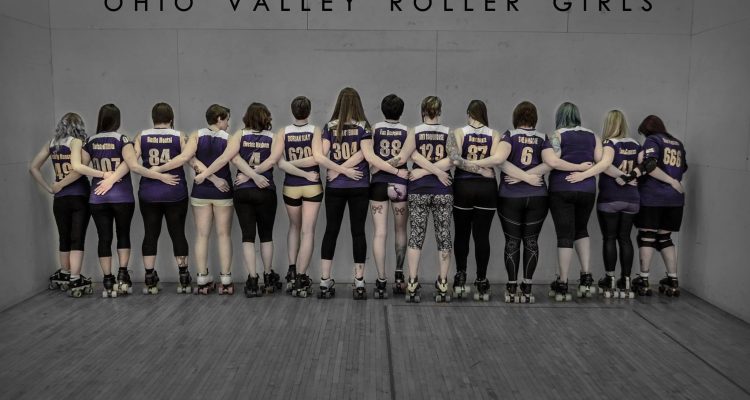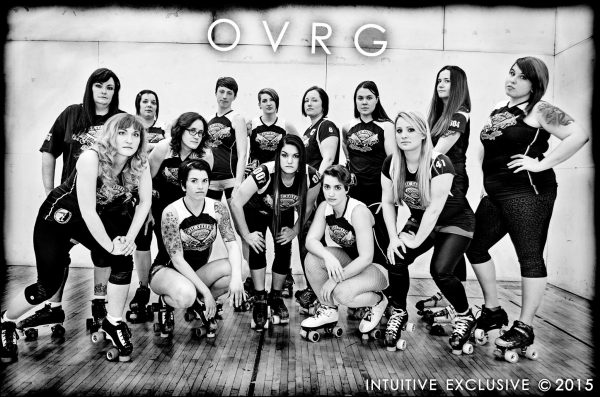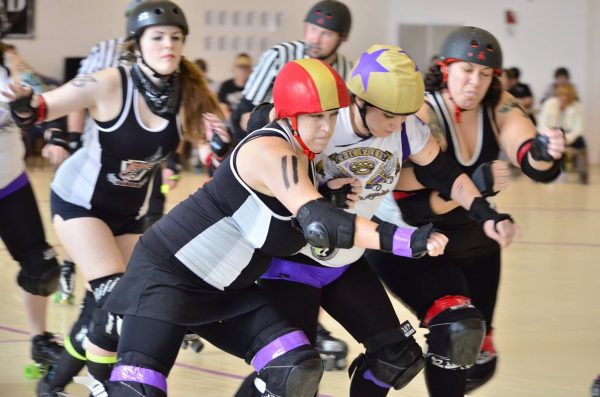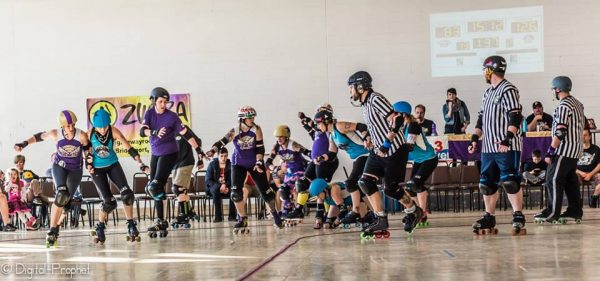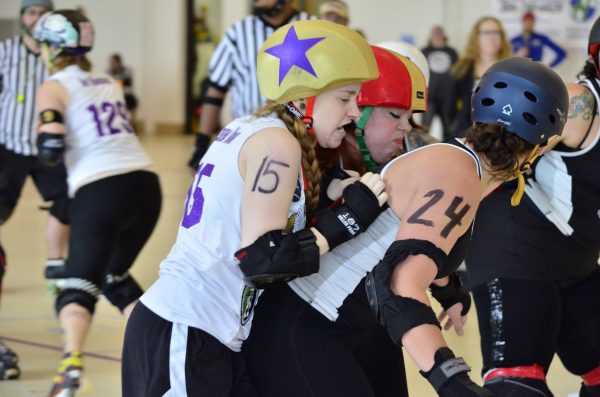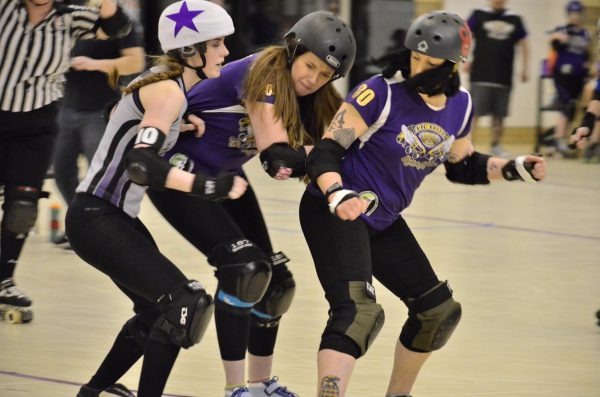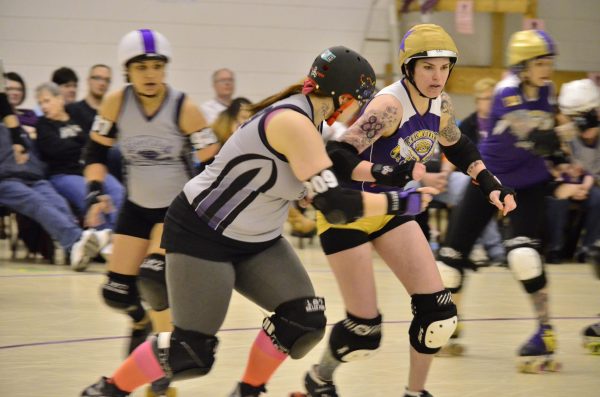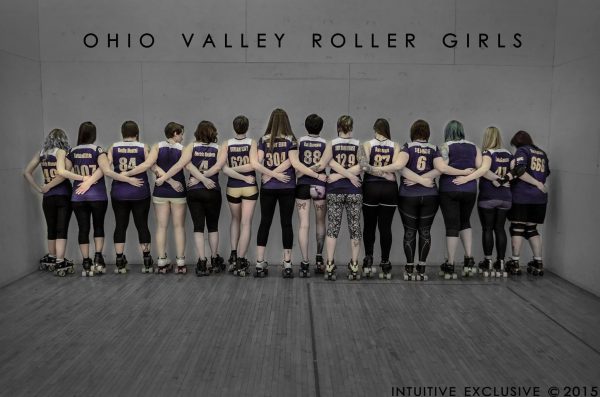I’m lying on the concrete floor of the James E. Carnes Center in Belmont County, Ohio. My feet are laced in roller skates and protective gear (elbow and knee pads, wrist guards, and helmet) is strapped to my limbs. I’m listening to the crowd cheering, the metallic whirl of wheels, the grunts and shouts of other skaters. And I’m willing myself to stand up.
https://www.youtube.com/watch?v=LZZ-XwJNenI
You see, I’m playing roller derby with the Ohio Valley Roller Girls, and I’ve just been knocked to the ground by a powerful hit from the opposing team. I’m skating as my team’s jammer at the moment, which means that it is my job to score points by maneuvering my body around the members of the opposing team, so it is imperative that I get off the ground and back on the track as quickly as possible. And I am tired. This is our second game in as many days, and it is one of the toughest games of the season. I look up: How many minutes are left on the game clock?
Scrambling to my feet and positioning myself to re-enter the track, I notice that the skater responsible for sending me flying out of play is watching me with a half-smile on her face. Maybe it’s a smile of satisfaction for having taken me out of contention for a few seconds. Maybe she’s trying to intimidate me. But there seems to be something else going on, too. Beneath her competitive veneer, I sense her daring me back into the game—willing me to keep going and to dig a little deeper. So I do.
This, to me, is modern roller derby in a nutshell: It is a sport that allows—more than that, it is a sport that encourages—women to act as one another’s fiercest competitors as well as their fiercest allies. It is a sport that allows women to be many things at once: powerful, vulnerable, aggressive, kind. I’ve had opposing team members give me a hug in the middle of a game, then proceed to make my life a living hell with skillful blocking. I’ve gotten high fives from opposing jammers mere seconds before the whistle blew and we sought to leave each other in the dust. And I’ve spent many hours at the post-game after party, following both victories and defeats, dancing with the other team, all of us soaked in sweat and glowing with exertion.
There aren’t many spaces in our culture that make room for these kinds of female relationships. Rather, we are told that we are each other’s enemies: for romantic partners, for professional success, for beauty. Time magazine asks: Are you mom enough? US Weekly asks: Who wore it best? Rivers of mascara flow on The Bachelor as women plot one another’s ruin. Roller derby says something different about women and their capacities for friendship, generosity, and inner reserve. Those of us who play roller derby know this well, and it is why we keep coming back for more.
Make no mistake; roller derby is intensely competitive. But it is competition rooted in community. When we work to achieve milestones in this sport, such as the ability to skate 27 laps in five minutes (no small feat, I assure you), we’re working together. We aren’t chugging away on the solitary hell of the treadmill; we’re trying to catch that skater who is always just a few feet ahead of us, and we’re encouraging that skater who lags behind. We’re exercising not to be beautiful, but to be strong—for ourselves and for each other.
I realize that this all sounds very romantic, but I don’t care. If you aren’t involved in roller derby, either as a skater, a volunteer, or a fan, then, quite simply, you are missing out on something special. You may be one of those individuals who doesn’t know that modern roller derby even exists, so let me do you the favor of introduction: roller derby is in the Ohio Valley and it is awesome.
The Ohio Valley Roller Girls formed in 2010 and play under the rules and minimum skills established by the Women’s Flat Track Derby Association (WFTDA), the primary governing body for the sport. The WFTDA is responsible for ranking its 308 member leagues, which are divided into Divisions 1-3, and for hosting an annual playoff and championship series consisting of teams from all over the world: North and South America, Europe, Asia, and as far away as Melbourne, Australia. The OVRG is made up of skaters from eastern Ohio, western Pennsylvania, and the northern panhandle of West Virginia. These skaters come from all walks of life, converging three nights a week in the Martin’s Ferry Recreation Center to prepare for competitive play against teams from around the eastern United States.
If you watched roller derby in the 1970s, the sport looks very different today. The Silicon Valley Roller Girls, located in San Jose, Calif., provide a useful microhistory of the sport on their website:
Modern Roller Derby has evolved from over a century of roller-skating sports. In the early 1900s speed and endurance races were popular, leading Leo Seltzer (commonly known as the “father of roller derby”) to form the Transcontinental Roller Derby in the 1930s. While these were marathon events, short sprint “jams” were featured, and physical contact between skaters began to be encouraged as it proved popular amongst the fans. In the late 1940s and 50s, Seltzer formed the National Roller Derby League (NRDL), which included the legendary San Francisco Bay Bombers. The NRDL featured “theatrical” whips, hits, and elbows.
The modern roller derby revival started in the early 2000s in Texas. Modern roller derby is comprised of many female skater-owned and operated leagues. Most leagues skate on flat tracks, but some also feature banked-track competition.
The complete rules governing modern roller derby can be found on the WFTDA website. In a throwback to the sport’s earlier iterations, many modern roller derby skaters choose to use skater names or alter egos—such as Grenadrienne, Gnarly Manson, and Sween Machine, all members of the OVRG—but this does not lessen the intensity of what they do when they roll out onto the track. The physical contact that takes place in modern roller derby is no longer staged, as this compilation of clips from OVRG’s 2014 season, compiled by Eric Romero, the official videographer for OVRG and many other roller derby leagues in the region, amply demonstrates. Roller derby involves a lot of falling down—and a lot of getting up.
The bumps and bruises are plentiful, but so are the rewards.
Aside from the skaters who make up the team, the roller derby community relies upon a host of other individuals—referees, announcers, non-skating officials, and other skilled and generous volunteers—who are critical to the sport’s existence. Their contributions make plain that roller derby is a grassroots endeavor in which the entire community, not just the women on the track, can take pride. And the OVRG is dedicated to giving back to the local community. In the past several years, the OVRG has donated money to Webark Estates; Wheeling Health Right; Camp Catch Your Breath; the Wheeling Soup Kitchen; the Marshall County Animal Shelter; Florence Crittenton Services; and other charitable organizations right here in the Ohio Valley.
One of my teammates refers to roller derby as a secret sisterhood, and I think she’s right. We are hiding in plain sight, as it were. Chances are, one of us has served your dinner, cared for your loved one in the hospital, or taught your children in school. And three nights a week, we put those other parts of our lives on hold and challenge each other to be the selves that we didn’t know existed before derby came along. “I am supported by my derby family in ways I could never have imagined. They make me feel like I can do anything,” reports Alex “Lorena Vomit” Wright, an OVRG skater. Christa “Electric Mayhem” Kerns relays that she started playing roller derby at a tough time in her life, and that “it was the positive atmosphere that I needed, with people who were welcoming and encouraging”; for her, OVRG has been a place “to find out what I am capable of as a human.”
And roller derby isn’t just for adults or for women; men’s roller derby followed on the heels of women’s roller derby, and many leagues engage in co-ed play, giving women and men a chance to test their skills in an environment of mutual respect. Junior roller derby is gaining momentum among young men and women around the world. “I love the skills and confidence my daughter is building. Not only on the track but in everyday life,” reports Jill McDowell Walter, mother of Ryleigh “Roonado” Murphy of OVRG’s junior roller derby team.
Confidence. Encouragement. Capability. Family. These elements are what make modern roller derby so special, and what have made it so fundamental in my own life. When I find myself feeling rundown after work on a Thursday evening, not sure if I have the energy to pack up my gear and venture out to practice, I remind myself of what I’ll be missing if I stay at home. No matter how tired I feel, those hours spent on the couch will not reward me in the way that those hours spent on the track, surrounded by my derby sisters, surely will. The remote control will not test my mental and physical limits. It will ask nothing of me, and it will give me nothing in return. I choose the daring and the richness that roller derby offers, and I challenge you to do the same.
The next OVRG home game will take place on April 18, 2015 at the James E. Carnes Center. I’ll see you there!
For information about becoming involved with the Ohio Valley Roller Girls, as a skater, referee, or volunteer, contact ovrg@ohiovalleyrollergirls.com. Every Sunday, from 5-6pm, OVRG hosts a training class for new skaters. Interested skaters should fill out the recruitment form on the league website. You can also find us on Facebook.
(All photos courtesy of Shon Higgs of Intuitive Exclusive.)


